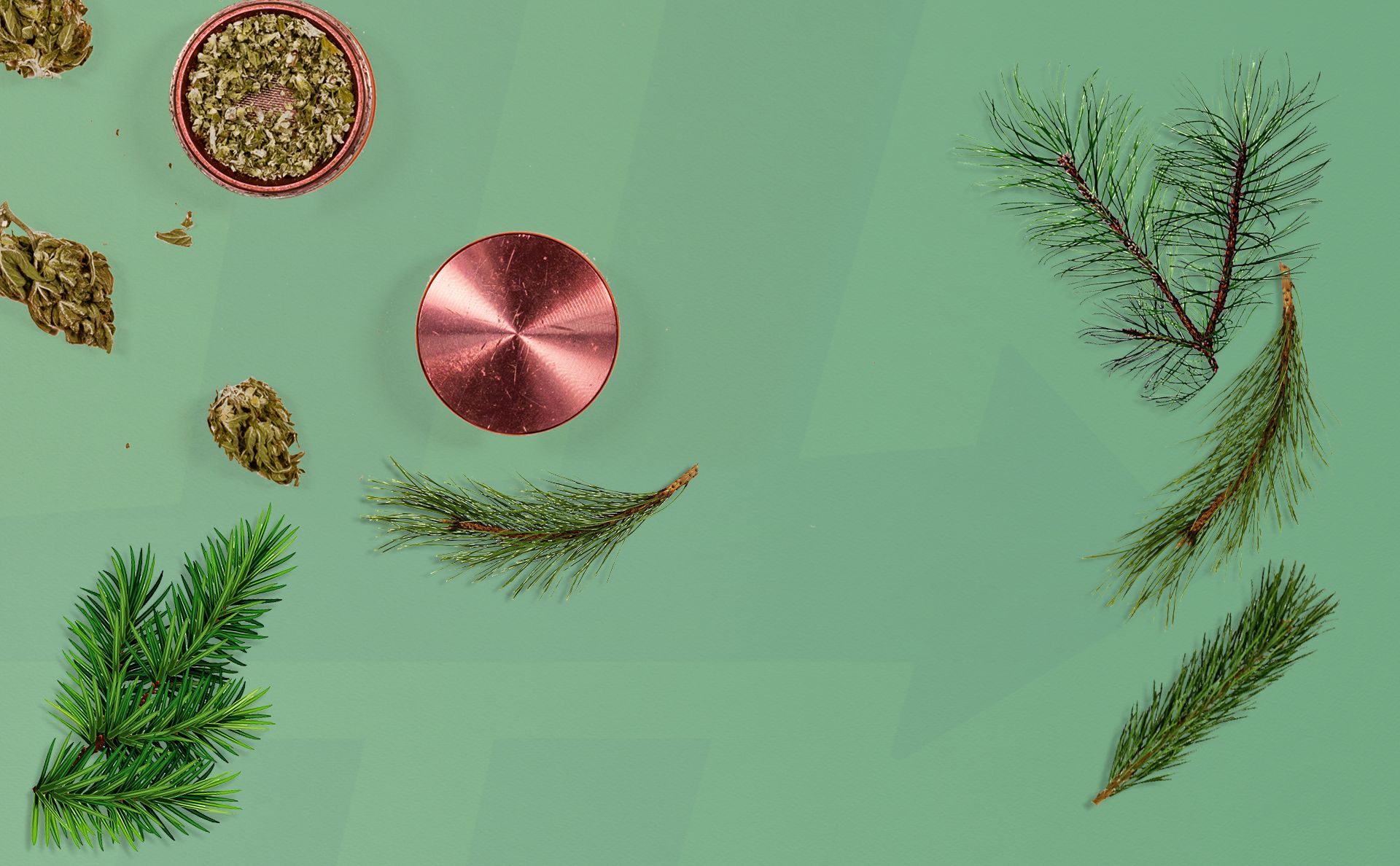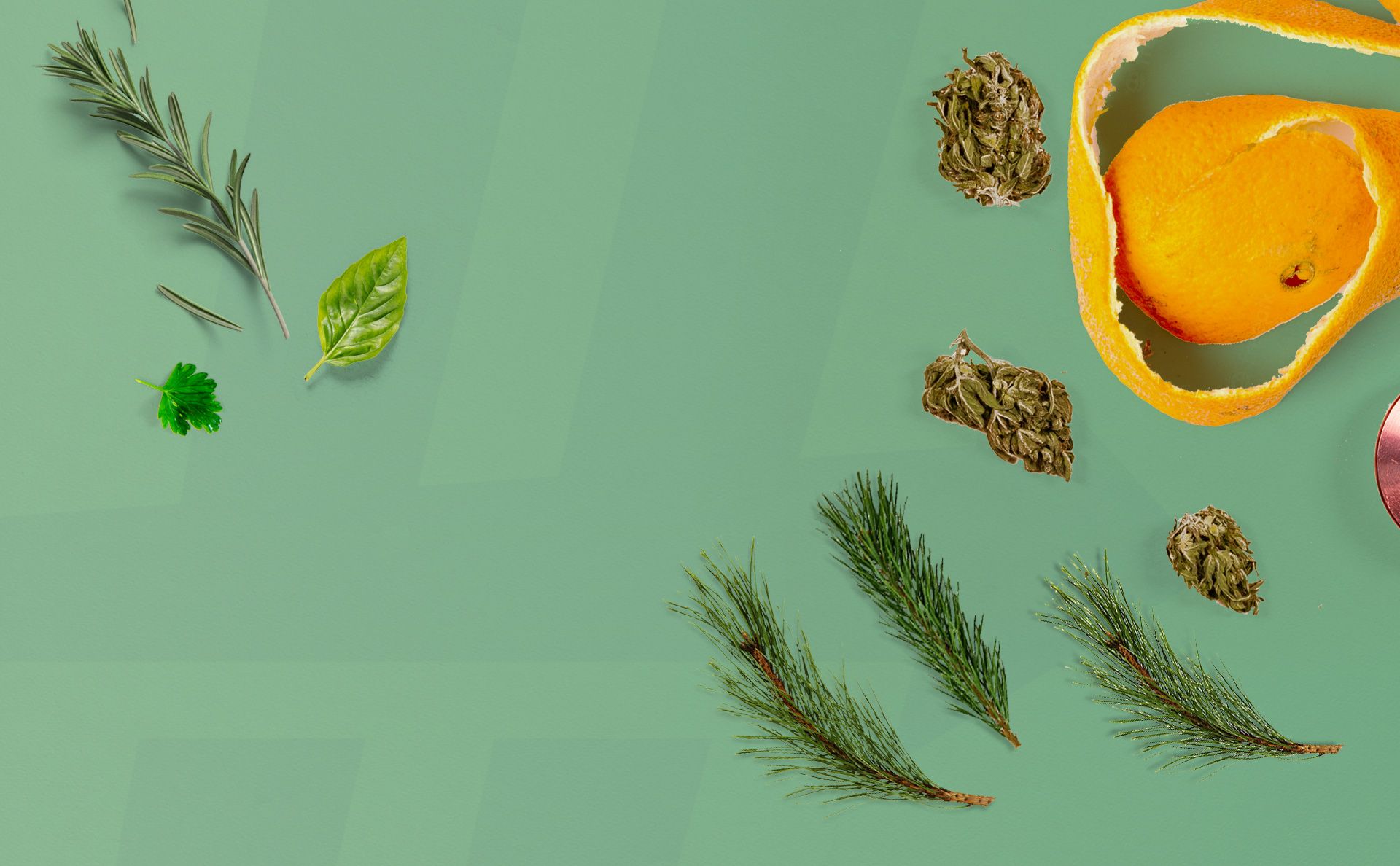Pinene
In this chapter, we cover the terpene that may remind you of the forest, known as pinene. Does pinene have any benefits, and if so, what are they? How does pinene smell and taste when it’s present in cannabis? We answer these questions right here.

In this chapter, we break down the terpene pinene. What is pinene, what does it smell and taste like, and does it have benefits? Read on for these answers and more.
What is Pinene?
Pronounced “pie-neen,” the terpene pinene is abundant in forest trees like conifers, and especially in the needles of pines, as its name suggests. Trees tend to be the plants that contain the most terpenes in the natural world, and pinene is the earth’s most abundant terpene.
Pinene is a highly effective natural insect repellent. This terpene is also the main ingredient in wood turpentine.
Already in your foods, pinene makes many appearances in various herbs, spices, and fruits including:
- Rosemary
- Basil
- Dill
- Parsley
- Black pepper
- Coriander
- Thyme
- Juniper
- Oranges
Pinene, like many terpenes, was originally formulated as a plant’s natural defense mechanism against predators. In cannabis, terpenes are secreted through trichomes, adding rich flavors, aromas, and potential benefits to your favorite cultivars.
Terpene Flavor and Aroma Profile: Pinene
Pinene-dominant cultivars are rare, but can be popular. One such example of this is Big Smooth. This unique cultivar proves that rarer terpenes can be the star of the show when the primary terpenes in most cultivars are that of myrcene, caryophyllene, and limonene.

Pinene gives cultivars a uniquely woody flavor with hints of sweetness and earthiness. Some of the most popular cultivars that contain relatively high levels of pinene include:
- Jack Herer
- Remedy
- God’s Gift
- Cannatonic
- Harlequin
- Kosher Tangie
- Blue Dream
- Sour Diesel
- ACDC
- Chemdawg
- Trainwreck
- Super Lemon Haze
- Lemon Skunk
- Skunk Haze
- Blue Cheese
- Banana Blaze
- Cinderella Jack
- White Widow
There are also differences between alpha and beta-pinene levels between cultivars. For example, Lemon Skunk and CBD Skunk Haze are dominant in alpha-pinene. Meanwhile, beta-pinene dominates in Purple Kush.

What the expert says...
Dr. Abraham Benavides
"Pinene may help increase short-term memory and counteract the deficits caused by THC intoxication."
Does Pinene Get You High?
No, pinene does not get you high. However, pinene may play an interesting and conflicting role in the entourage effect.
Pinene comes in several varieties, but two major forms, alpha and beta, are of most cannabis research interest. Alpha and beta pinene act as a short-term memory booster, similar to drugs called acetylcholinesterase inhibitors we give to Alzheimer’s patients.
Even though they are nearly identical, new evidence suggests that beta pinene may also synergize with THC at the psychoactive CB1 receptor to increase its actions there. Being able to selectively choose these nuanced differences may help patients guide their terpene profile choice in cannabis products, where available.
This means that pinene may have a subtle impact on the consumer when combined with other compounds in whole-plant cannabis, like cannabinoids and other terpenes. As is the case with so many other aspects of cannabis, more research is needed to determine this, and how each consumer responds differently to each.
Potential Benefits of Pinene
As is the case with many terpenes, there are a few potential benefits of pinene. Most remarkably, is its ability to increase short-term memory and even lessen the short-term memory problems caused by THC intoxication. Pinene is a natural bronchodilator as well as an effective antiseptic, even against MRSA.
Studies also suggest that pinene can be used to alleviate inflammation, and this versatile terpene may be useful and effective as a pain reliever. Preliminary research also suggests that pinene may have therapeutic benefits for those who suffer from symptoms of anxiety.
Based on similar early research, other potential use cases for pinene include:
- Anti-Alzheimer’s agent
- Antioxidant
- Antidepressant
- Sleep-inducing
- Anticancer and chemosynergy effects
- Neuroprotective
- Wound healing
- Anticonvulsant
- Antidiabetic
- Hypolipidemic
- Gastroprotective
- Kidney stones
What We Learned: Pinene
As we continue to see cannabis research progress forward, we could see the known benefits of terpenes like pinene increase. Here’s what we learned about the terpene pinene:
- Pinene has the most woody aroma and flavor of all the terpenes
- Pinene is the main ingredient in wood turpentine
- The world’s most abundant terpene, pinene, is a natural insect repellent
- Pinene is found in orange peels, basil, parsley, and dill
- Some of the most popular cultivars that contain relatively high levels of pinene include Jack Herer, Remedy, God’s Gift, Cannatonic, Harlequin, Kosher Tangie, and Blue Dream
- Studies show pinene is a short-term memory booster, countering THC fog, pain-reliever, natural bronchodilator, an effective antiseptic, and may act as an anti-inflammatory
The future is bright for the wonderful world of terpenes, and only time will tell how much more we can learn about these valuable natural compounds.
You've come far on your journey in learning about Terpenes. You are close to completing this chapter. Answer the below question and get one step closer.
Citations
- Al-Khazaleh, A. K., Zhou, X., Bhuyan, D. J., Münch, G. W., Al-Dalabeeh, E. A., Jaye, K., & Chang, D. (2024). The Neurotherapeutic Arsenal in Cannabis sativa: Insights into Anti-Neuroinflammatory and Neuroprotective Activity and Potential Entourage Effectshttps://doi.org/10.3390/molecules29020410
- Benavides, A. (2022, July 29). Pinene—Terpenes and Cannabinoid Research. Cannakeys.https://cannakeys.com/pinene-terpene-research/
- Cox-Georgian, D., Ramadoss, N., Dona, C., & Basu, C. (2019). Therapeutic and Medicinal Uses of Terpenes. Medicinal Plants, 333–359.https://doi.org/10.1007/978-3-030-31269-5_15
- de Cássia da Silveira e Sá, R., Lima, T. C., da Nóbrega, F. R., de Brito, A. E. M., & de Sousa, D. P. (2017). Analgesic-Like Activity of Essential Oil Constituents: An Update. International Journal of Molecular Sciences, 18(12), 2392.https://doi.org/10.3390/ijms18122392
- Falk-Filipsson, A., Hagberg, M., Löf, A., Wigaeus-Hjelm, E., & Wang, Z. (1990). Uptake, distribution and elimination of ??-pinene in man after exposure by inhalation. Scandinavian Journal of Work, Environment & Health, 16, 372–378.https://doi.org/10.5271/sjweh.1771
- Gulluni, N., Re, T., Loiacono, I., Lanzo, G., Gori, L., Macchi, C., Epifani, F., Bragazzi, N., & Firenzuoli, F. (2018). Cannabis Essential Oil: A Preliminary Study for the Evaluation of the Brain Effects. Evidence-Based Complementary and Alternative Medichttps://doi.org/10.1155/2018/1709182
- Hanuš, L. O., & Hod, Y. (2020). Terpenes/Terpenoids in Cannabis: Are They Important? Medical Cannabis and Cannabinoids, 3(1), 25–60.https://doi.org/10.1159/000509733
- Kim, D. H., Goh, H. J., Lee, H. W., Kim, K. S., Kim, Y. T., Moon, H. S., Lee, S. W., & Park, S. Y. (2014). The Effect of Terpene Combination on Ureter Calculus Expulsion After Extracorporeal Shock Wave Lithotripsy. Korean Journal of Urology, 55(1), 36–40.https://doi.org/10.4111/kju.2014.55.1.36
- Liktor-Busa, E., Keresztes, A., LaVigne, J., Streicher, J. M., & Largent-Milnes, T. M. (2021). Analgesic Potential of Terpenes Derived from Cannabis sativa. Pharmacological Reviews, 73(4), 1269–1297.https://doi.org/10.1124/pharmrev.120.000046
- Raz, N., Eyal, A. M., Zeitouni, D. B., Hen-Shoval, D., Davidson, E. M., Danieli, A., Tauber, M., & Ben-Chaim, Y. (2023). Selected cannabis terpenes synergize with THC to produce increased CB1 receptor activation. Biochemical Pharmacology, 212, 115548.https://doi.org/10.1016/j.bcp.2023.115548
- Russo, E. B. (2011). Taming THC: Potential cannabis synergy and phytocannabinoid-terpenoid entourage effects. British Journal of Pharmacology, 163(7), 1344–1364.https://doi.org/10.1111/j.1476-5381.2011.01238.x
- Salas-Oropeza, J., Jimenez-Estrada, M., Perez-Torres, A., Castell-Rodriguez, A. E., Becerril-Millan, R., Rodriguez-Monroy, M. A., Jarquin-Yañez, K., & Canales-Martinez, M. M. (2021). Wound Healing Activity of α-Pinene and α-Phellandrene. Molecules, 26(9),https://doi.org/10.3390/molecules26092488
- Santos, E. S., Abrantes Coelho, G. L., Saraiva Fontes Loula, Y. K., Saraiva Landim, B. L., Fernandes Lima, C. N., Tavares de Sousa Machado, S., Pereira Lopes, M. J., Soares Gomes, A. D., Martins da Costa, J. G., Alencar de Menezes, I. R., Coutinho, H. D. https://doi.org/10.1155/2022/8173307
- Siracusa, L., Ruberto, G., & Cristino, L. (2023). Recent Research on Cannabis sativa L.: Phytochemistry, New Matrices, Cultivation Techniques, and Recent Updates on Its Brain-Related Effects (2018–2023). Molecules, 28(8), 3387.https://doi.org/10.3390/molecules28083387
- Sommano, S. R., Chittasupho, C., Ruksiriwanich, W., & Jantrawut, P. (2020). The Cannabis Terpenes. Molecules, 25(24), 5792.https://doi.org/10.3390/molecules25245792
- Tomko, A. M., Whynot, E. G., Ellis, L. D., & Dupré, D. J. (2020). Anti-Cancer Potential of Cannabinoids, Terpenes, and Flavonoids Present in Cannabis. Cancers, 12(7), 1985.https://doi.org/10.3390/cancers12071985
- Weston-Green, K., Clunas, H., & Jimenez Naranjo, C. (2021). A Review of the Potential Use of Pinene and Linalool as Terpene-Based Medicines for Brain Health: Discovering Novel Therapeutics in the Flavours and Fragrances of Cannabis. Frontiers in Psychiatrhttps://doi.org/10.3389/fpsyt.2021.583211
- Wróblewska-Łuczka, P., Cabaj, J., Bargieł, J., & Łuszczki, J. J. (2023). Anticancer effect of terpenes: Focus on malignant melanoma. Pharmacological Reports, 75(5), 1115–1125.https://doi.org/10.1007/s43440-023-00512-1
Test your knowledge, track your progress and earn your badge.
Does pinene get you high?

Dr. Abraham Benavides
Dr. Abraham Benavides is an internationally-recognized cannabis research expert, experienced medical advisor, and full-tuition merit scholar of the George Washington University School of Medicine and Health Sciences. Dr. Abe enjoys helping patients as a writer, educator, and cannabis health coach at the GW Center for Integrative Medicine.